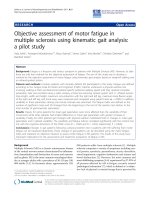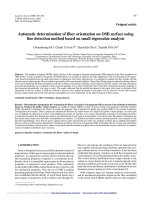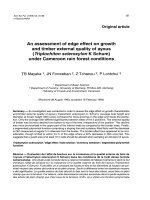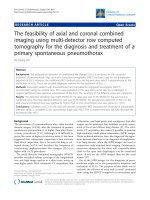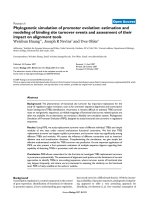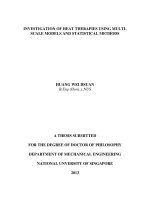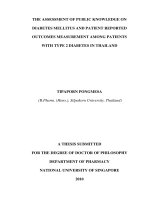Assessment of structural performance of steel building on shake table using multi input multi output models
Bạn đang xem bản rút gọn của tài liệu. Xem và tải ngay bản đầy đủ của tài liệu tại đây (1.75 MB, 80 trang )
3―1
Assessment of Structural Performance of Steel
Building on Shake Table Using Multi Input
Multi Output Models
Academic Year
2010
Ho Thu Hien
Master’
ster ’s Thesis
Academic Year
Year 2010
2010
Keio University
Graduate School of Science and Technology
School of Science for Open and Environmental Systems
Systems
As we know, earthquakes have caused many serious damages; that is why it
is needed to study the health of buildings after these earthquakes. After a
large earthquake, evaluation of damage of structures is an important task
for health assessment. Vibrations of buildings give us valuable information
on it. Changes in the modal properties like natural frequencies, modal
shapes and modal damping are very important to assess the structures.
Among the representative structural characteristics, natural frequencies
provide the global information. However they are relatively simple, accurate
to measure and easy to obtain. Besides, the changes in frequencies must be
considered to assess the health of structure. When the frequency shifts give
the general health assessment, the mode shape changes can be categorized
up to the higher level of damage identification – determination of the
geometric location of the damage.
This study will consider the frequencies shifts and their mode shapes with
various levels of seismic excitations. The excitations are represented by
different intensity levels of the 1995 Hyogoken Nanbu Earthquake that are
obtained in JR – Takatori Station. The acceleration data of E–defense tests
on full scale 4 story steel building will be analyzed. Five sets of acceleration
data were measured at center and 4 corners on shake table and 4 stories of
the full scale model were considered as inputs and outputs signals of many
types of multi input multi output (MIMO) models. From the defined models,
some first mode natural frequencies of structure will be obtained and
compared to each other. By analyzing the two first mode natural frequencies
of X and Y directions, the capacity of structure will be assessed with its
performance. The aim of this research is to assess the capacity of a steel
building after a seismic activity using real size shake table tests.
Course No
!"
#
!
"
#
$
%
&''(
-
$
$
%
)
*
*#
"
0
+, # $
./
.
.
/
/
/
123245
0
"
7
6
$
/ "
$
0
3
%
8
2
2
92 :
2 4
2 4
3
2 2
2 -
12 6
:
2 :
2 -
0
2 )
2 2
2
2 ;
2
2 3
2
2 :
5
<
3
12
2 $
2
*
-
+
5
3
!
8
&&
4
&
&=
.
&>
4 ?
@
&.
4
=&
3
&A
==
*/B
&&
=>
0
"
/
$
./
'
&=
=.
*%
=(
,
>&
3
&'
>=
)
=C
>>
8
=@
>.
*%
>.
!
&(
%
"
&C
"
!
.&
3
.>
.=
2324
.(
.>
2324
.C
.C
.@
#
#
$
0
=&-
&=
0
==0
0
=>8
0
=.
0
=(
0
>&
0
>=;
0
>> ,2
0
> . ,6 2
0
> ( ,2 6 2
0
>C$
0
>D-
/
./
&>
(
8
*
&.
-
&D
$
15
/F
2
&AA E
15
-
&@
15
=(
='
-
>A
-
>&
-
>=
+,/$
>(
+,/$
>C
0
>@
1 G =5
+,/$
>@
(E
0
>'$
0
> &A &
)
0
> &&
0
0
> &= =
)
0
.&$
8-B
>'
0
.&
.&
0
-3-4
.=
6
7
13
*/B
.C
5
0
. = H=
=
0
. > H.
.
I
13
*/B
5
.D
0
. . H.
.
I
13
*/B
5
.@
0
.(&
)
0
0
.C&
)
0
(A
0
.D&
)
0
(A
0
.@=
)
0
(&
0
.'=
)
0
(&
0
. &A B
)
0
/&
(=
0
. && B
)
0
/=
(=
0
. &= $
&
I
13
*/B
F
H=
@
5
96
I
97
.D
.'
(.
0
. &> $
&
H.
&C
I
((
0
. &. $
&
H.
&C
I
(C
0
. &( 3
&
(D
0
. &C B
&
(D
%
8
$
=&-
-
-
&=
$
==$
$
=>-
%
&(
$
=.-
,
&D
$
=(B
$
.&&
$
.=&
+,/$
/
6
6
&AAE
&(
&@
7
.'
7
(@
%
!
!
#
$
%
"
&
'
(
)
%
#
*
+
$
*
"
#
#
,
-
"
.(/
%
#
0
*
.(/
*
1
."2/
1
%
.""3"4/
*
&
1
%
*
3
3
%
)
."5/
%
1
%
%
."6/
0
3
7
:
884!
3;
9
"<<(!
7
9
888!
=
(
1
:
5 4<<
+
7
!
9
2
884 %
7
*
*
>?@ <<
.&
%
A
;
#
1
0
,
0
*
0
+
?
*
3
#
4
B
#
*
%
3
C
C
%
3
.4/ ?
*
*
*
3
C
*
#
#
A
5
D
#
AD#!
AD#
E
$E
+
GE
&F%
GE
F
GE
"F
(3;
0
E
0
+
*
+
1
;
,
%
?
%
*
+
*
1
2
%
*
+
*
*
884 1
9H F
:
?
F
(3
+
0
3
3
3
0#0,!
D
+
I
J
3 +
6
#
+
$
3
;
"
3
;
& *
*
?
3
;
(
0#0,
0#0,
3
;
4
#
*
8
0#0,
!
" #
$
%
&
'
"
)
#
*!
,
1
0
,
0
0
-
/
1
.
/
,
234
,
#
56 7*
# 68 9
$
#
* +,
( #
/
3
/
!
#
# 9
,
,
: 8 /
%
*!
:*
/
/
#
,
/
( #
"
*
!
;
0
/
,
, #
# /
0
#
1
,
# /
/
#/
0
* <
/
/ , 1
/
"
0
#
/
/
1
,
/
/ ,
/
.
,
#
=
#
#
0
,
#
#
/
* >
/
/
%
*!
* >
/ /
0
0
#
#
0
#
#
*9
,
, ;
/
,
0
9#
0 #
/
#
#
,
*
/,
,
/
#
, , /
#
*
,
# /
/
,
*
/
#
/
/ ,
#
8 /
# 0
0
,
/ ,
0
#
#*!
1
#
0
/ ,
* (
/
!
#
*9
, ,
( #
/
0
,
,
/
#
#
%*
!
%*
.
*!
0
*

